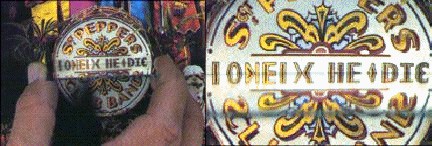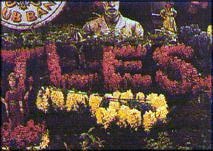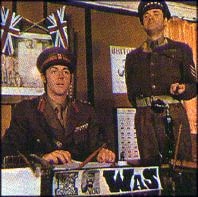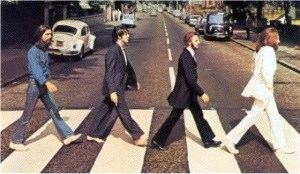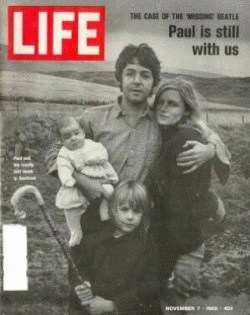WKNR and the “death” of Paul McCartney
On October 12, 1969, Keener killed Paul McCartney.
 Russ Gibb, working on WKNR-FM, heard from an Eastern Michigan University student about a series of clues that seemed to point to Paul McCartney’s death. The story took on a life of its own, both on Keener and WKNR-FM and Russ received credit for making the story of McCartney’s supposed demise a national story.
Russ Gibb, working on WKNR-FM, heard from an Eastern Michigan University student about a series of clues that seemed to point to Paul McCartney’s death. The story took on a life of its own, both on Keener and WKNR-FM and Russ received credit for making the story of McCartney’s supposed demise a national story.
It was a Sunday afternoon in Detroit when Uncle Russ took the call. He had just played some tracks from the Abby Road album and turned to the phone lines for his customary “rap” with his listeners. Eastern Michigan University student Tom Zarski was on the line. “I was going to rap with you about McCartney being dead and what is this all about?”
Gibb told us that his mind immediately went back to the Dylan is Dead rumor that circulated after the poet’s serious motorcycle crash in 1967. He began to review the litany of rumors floating around about the current crop of rock celebrities. Tom was insistent, claiming that there were clues on the Beatle’s records. “..play Revolution Number Nine backwards,” he said.
WKNR-FM’s audience heard “Turn me on, dead man” for the first time. ![]() Russ Gibb with UM Student John Miller
Russ Gibb with UM Student John Miller
The origin of the rumor is a bit more complicated. It may have had its genesis in a 1966 auto accident where Paul suffered minor injuries. Rolling Stone magazine heard the story as early as 1968 and by 1969 clues were circulating around college campuses. In the days leading up to the WKNR revelations, there were several published accounts. Tim Harper wrote an article on the subject on September 17th in the Drake University student newspaper. A similar article appeared in the University of Illinois campus daily six days later. University of Michigan undergrad Fred LaBour heard Russ Gibb’s October 12 broadcast. His article, published in the October 14 edition of the Michigan Daily as a record review parody, is often cited as providing the key exposure that helped propel the story beyond the local market. He admitted to Uncle Russ that much of his article was pure fabrication. ![]() Russ Gibb interviews Fred LaBour
Russ Gibb interviews Fred LaBour
I had just signed up at our all-volunteer campus station, WCBN AM 650 (at the University of Michigan) about that time and unbeknownst to our campus station manager, I called Apple Records live on the air. The fun in it was all the switching around, talking to operators, etc. (The station got the bill for the long distance call later and I caught hell for it, but it was worth it.)Anyway, one overseas operator stayed on the phone with me for the whole ordeal. We finally got through to the press office at Apple Records and I asked this woman is Paul was indeed, dead. She said in her lovely accent that, no he was quite alive and had been in the office that very afternoon.After this press lady hung up, I said to my associate, Al Hendry, “Well, I guess he’s still alive.”I didn’t know it but the overseas operator was still on the phone, live on the air and she said “I could have told you that!” There was exactly two seconds of silence, then everyone in the studio started laughing.Ken R. DeutschAuthor – The Jingle Book
Ann Arbor DJ Larry Monroe first heard the rumor from his younger brother and was talking about it on air with WOIA listeners as early as October 9th. Fellow WOIA jock Jim Curtis, the Ann Arbor air name of New York radio legend Jim Kerr — who was “Robin Stone” on Keener in 1971, called Apple in London for reaction. With the time difference, Jim got the night watchman who characterized the tale as, “.. a load of horseshit.”
By November 2nd, J. Marks had written an article for the New York Times disputing the allegations. He remembered finishing a project with Linda Eastman two years earlier. The future Mrs. McCartney expressed interest in meeting Paul but told Marks that she heard that he had died and had been replaced by a double. When the couple were married in March of 1969, Marks sent a note saying “Congratulations, whoever you are.”
RKO invited Paul Cannon, Russ Gibb and Fred LeBour to Hollywood to participate in a television show hosted by attorney F. Lee Bailey. The mock courtroom was the setting for a discussion of evidence surrounding the rumor. The program was broadcast in several RKO markets, including New York. All copies of the tape then mysteriously disappeared, adding an additional twist to the proceedings.
The Paul is Dead story peaked in America with the November 7 edition of Life magazine. The Life crew found the Beatle at his farm in Scotland and after some initial reticence, McCartney gave a detailed interview, debunking the myth that continues to interest Beatle fans to this day.
There are several versions of the Paul is Dead story. Here are a couple of the most popular iterations.
In one account, Paul was was decapitated in an automobile accident occurring in November of 1966 after an argument with the other Beatles at Abby Road studios (“He blew his mind out in a car” – A Day in the Life – Sgt. Pepper). Another version depicted a despondent Paul picking up a female hitchhiker who accidentally caused the wreck when she tried to get too close to the driving Beatle. The woman’s name was said to be Rita (“I took her home. I nearly made it.” – Lovely Rita, Meter Maid – Sgt. Pepper).
There’s an interesting postscript to the story. Chris Morton, who was in studio with Russ Gibb when during his fateful WKNR-FM broadcast visited London in the summer of 2001. He wrote to keener13.com to say, “We went on the walking Magical Mystery Tour in St. John’s Woods, ending up in front of Abbey Road Studios. I was delighted when the tour guide told a brief history of the affair, attributing its genesis to Detroit disk jockey Russ Gibb.”
Whatever its true origin, WKNR played a pivotal role in amplifying one of the more intriguing and macabre chapters of the history of the Beatles.
Other Paul is Dead Resources:
The Paul McCartney Death Rumor by Larry Monroe – The former Ann Arbor DJ’s Memory of the event
Turn Me On, Dead Man – by Andru J. Reeve, published by Popular Culture, Ink., 1994
Jose’s Historic National Anthem during the ’68 World Series
 40 years ago, 23 year old Jose Feliciano sat before a public address microphone at Tiger Stadium. Detroit was playing in the World Series and Tiger broadcaster Ernie Harwell was assigned the job of selecting the talent to render The National Anthem. Jose followed Marvin Gaye, who sang a straight version after the Tigers directed Harwell to admonish the Motown superstar to keep things traditional. Today, Jose’s rendition sounds tame in comparison to the diverse interpretations we hear at almost every sporting event. But in the day it generated a firestorm of controversy. Here’s NPR’s excellent remembrance of how it happened. (Special thanks to Keenerfan Jim Feliciano for the picture and recording of Jose’s performance at Michigan and Trumbull.)
40 years ago, 23 year old Jose Feliciano sat before a public address microphone at Tiger Stadium. Detroit was playing in the World Series and Tiger broadcaster Ernie Harwell was assigned the job of selecting the talent to render The National Anthem. Jose followed Marvin Gaye, who sang a straight version after the Tigers directed Harwell to admonish the Motown superstar to keep things traditional. Today, Jose’s rendition sounds tame in comparison to the diverse interpretations we hear at almost every sporting event. But in the day it generated a firestorm of controversy. Here’s NPR’s excellent remembrance of how it happened. (Special thanks to Keenerfan Jim Feliciano for the picture and recording of Jose’s performance at Michigan and Trumbull.)
The Soundtrack of Presidential Elections
 Bob Berry, Sunny 105’s exceptional afternoon guy, sent me this Starpulse article that wonders why the Republicans can’t get any good bands in their tent this election cycle. That took us back to the 1960 election when Ole Blue Eyes donated his pipes to help elect John F. Kennedy with this tune. As a bonus, here’s what a Kennedy TV commercial looked like, back before negative advertising dominated.
Bob Berry, Sunny 105’s exceptional afternoon guy, sent me this Starpulse article that wonders why the Republicans can’t get any good bands in their tent this election cycle. That took us back to the 1960 election when Ole Blue Eyes donated his pipes to help elect John F. Kennedy with this tune. As a bonus, here’s what a Kennedy TV commercial looked like, back before negative advertising dominated.
Where You Gonna Go?
 Detroit Garage Band enthusiasts will be interested in?Cicadelic Records new “Where You Gonna Go” collection. Two of the best garage bands from Michigan, The Unrelated Segments whose “The Story Of My Life”has appeared on Rhino’s Nuggets box set and The Tidal Waves who scored a number one hit with “Farmer John” take center stage in this collection. All of The Unrelated Segments and The Tidal Waves material are included on this CD, re-mastered from original elements. Also featued are The Boys, The Quintette Plus, The Unknowns, The District Six, The Couriers and The Lykes of Us.
Detroit Garage Band enthusiasts will be interested in?Cicadelic Records new “Where You Gonna Go” collection. Two of the best garage bands from Michigan, The Unrelated Segments whose “The Story Of My Life”has appeared on Rhino’s Nuggets box set and The Tidal Waves who scored a number one hit with “Farmer John” take center stage in this collection. All of The Unrelated Segments and The Tidal Waves material are included on this CD, re-mastered from original elements. Also featued are The Boys, The Quintette Plus, The Unknowns, The District Six, The Couriers and The Lykes of Us.
Buddy Harman – Music Row’s Hal Blaine
 You heard him on Keener playing the drums on Roy Orbison’s “Pretty Woman” and Roger Miller’s “King of the Road”. But Buddy Harman, who died August 21 at age 79 is being remembered as the Father of modern country drumming. That’s him on the skins on Johnny Cash’s “Ring of Fire,” Elvis Presley’s “Little Sister,” Patsy Cline’s “Crazy,” Tammy Wynette’s “Stand By Your Man,” and Ray Price’s “Crazy Arms.” He became the first well known percussionist in the country genre, was the Grand Ole Opry’s first staff drummer, and provided the back beat that made Country hot stuff during the rock era.
You heard him on Keener playing the drums on Roy Orbison’s “Pretty Woman” and Roger Miller’s “King of the Road”. But Buddy Harman, who died August 21 at age 79 is being remembered as the Father of modern country drumming. That’s him on the skins on Johnny Cash’s “Ring of Fire,” Elvis Presley’s “Little Sister,” Patsy Cline’s “Crazy,” Tammy Wynette’s “Stand By Your Man,” and Ray Price’s “Crazy Arms.” He became the first well known percussionist in the country genre, was the Grand Ole Opry’s first staff drummer, and provided the back beat that made Country hot stuff during the rock era.
New 1970 Airchecks!
What’s the ideal July 4th present for a Keenerfan? We got it when the red and green VU meter logo of Bob Green Productions graced our mailbox. The legendary WKNR production and programming ace found a box of cassettes in his vault that yielded these two 1970 Keener gems. There’s this extended Bob Green aircheck that gives you a feel for the Keener vibe during its second run for glory. The jingles are a mixture of Clyde and classic Keener jingles and an eclectic combination of current hits and WKNR gold. Bob’s presentation is straight ahead, playin the hits personality. His encyclopedic knowledge of the hits is in evidence and he makes it look all too easy, even when a planned record doesn’t want to play. Then we have Scott Regen, the night after R. Dean Taylor was his studio guest. Juxtapose this piece against his early Keener work and you’ll instantly feel the evolution into a more mature, yet perfectly executed performance. This was radio that you could leave on all day. Even as the playlists tightened up, the personality kept us coming back for more.
The New Beach Boy Box Set
 On June 10, Capitol released a box set with the Beach Boys US Singles from their 1962-1966 prime. This 66 track collection features both the A and B sides, the original mono mixes, stereo mixes and a ton of other goodies that we’ve come to expect with Beach Boy re-releases. It includes a 48 page hardbound book. Capitol has the new media marketing nailed too. The official Beach Boy website has a special section devoted to the box set that includes a flash player allowing you to listen to your favorite tune in its original glorious mono format.
On June 10, Capitol released a box set with the Beach Boys US Singles from their 1962-1966 prime. This 66 track collection features both the A and B sides, the original mono mixes, stereo mixes and a ton of other goodies that we’ve come to expect with Beach Boy re-releases. It includes a 48 page hardbound book. Capitol has the new media marketing nailed too. The official Beach Boy website has a special section devoted to the box set that includes a flash player allowing you to listen to your favorite tune in its original glorious mono format.
At Keener13.com, we have all the original Beach Boy singles on 45, every Beach Boy LP?and just about every Capitol CD re-issue, including the first box set. Even though we haven’t bought one music CD during the last year, we’re headed to Borders to get this collection. The packaging and the aggregated content can’t be duplicated on ITunes and the product is created with such attention to detail and class, that it will be well worth the investment.
I’m thinking about how carefully the Disney folks manage their brands. They study every possible marketing channel and have found ways to package their products in every conceivable format to maximize the customer value add and associated cash flow. As the RIAA and record companies lament mp3 sharing, packages like this are the way to regenerate interest and supercharge sales.
Laugh-In’s Dick Martin Dies
From the AP: Dick Martin, the zany half of the comedy team whose “Rowan and Martin’s Laugh-In” took television by storm in the 1960s, making stars of Goldie Hawn and Lily Tomlin and creating such national catch-phrases as “Sock it to me!” has died. He was 86.
The Originals
 Detroit had its share. And if you were looking for rare records during the WKNR era, you looked for the so-called “used record stores” that were occasional fixtures in strip mall corners across the Motor City. As we evolve from LP to CD to MP3, most have faded into history. Across the way in East Lansing, Dick Rosemont had his own iteration, calling it “Flat, Black and Circular“. Three decades later, he’s still in business and his web presence is expanding to include a site that track down original recordings of popular and hit records. Here’s keener13.com curator Scott Westerman’s appreciation.
Detroit had its share. And if you were looking for rare records during the WKNR era, you looked for the so-called “used record stores” that were occasional fixtures in strip mall corners across the Motor City. As we evolve from LP to CD to MP3, most have faded into history. Across the way in East Lansing, Dick Rosemont had his own iteration, calling it “Flat, Black and Circular“. Three decades later, he’s still in business and his web presence is expanding to include a site that track down original recordings of popular and hit records. Here’s keener13.com curator Scott Westerman’s appreciation.
Share your opinions on our new and improved Keener Forum
The WKNR Forums are back and better than ever. Head right this way and you’ll be able to discuss 60s pop culture, Motown, Michigan Rock, Detroit radio & TV and anything remotely Keener connected. Please avoid the flames as we’re a friendly bunch, but have fun and make some new friends!
Treasures
 What if someone called you one evening and offered a collection of thousands upon thousands of carefully preserved jingles from the golden age of?Top-40 radio? Keener13.com curator Scott Westerman tells the tale of how he came to own over 300 hours of 60s rock radio jingles, including every cut that ever played on WKNR.
What if someone called you one evening and offered a collection of thousands upon thousands of carefully preserved jingles from the golden age of?Top-40 radio? Keener13.com curator Scott Westerman tells the tale of how he came to own over 300 hours of 60s rock radio jingles, including every cut that ever played on WKNR.

